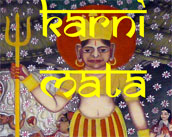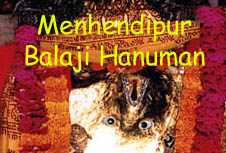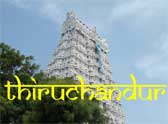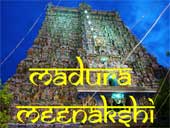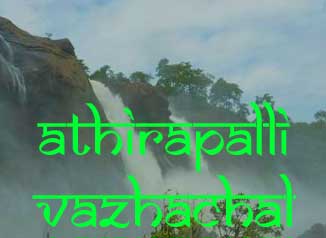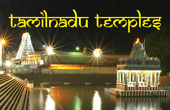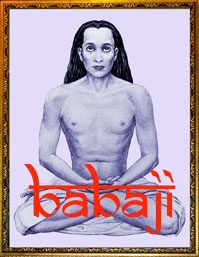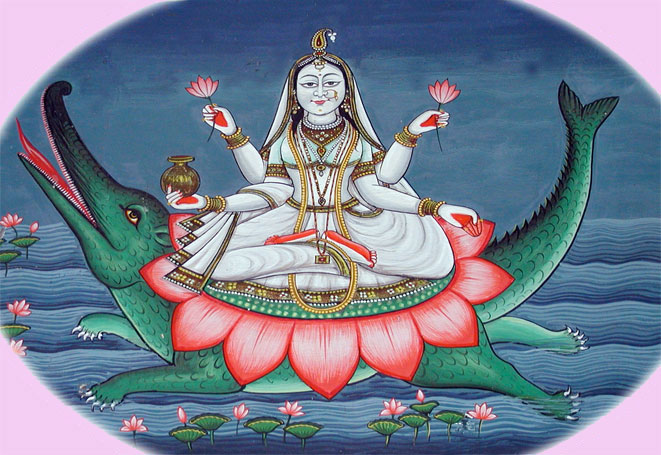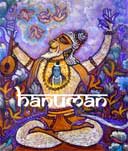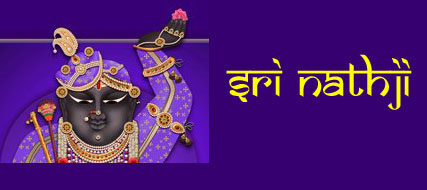 Sri Nathji
I had been to the beautiful shrine of Sri Nathji 22 years ago and had never been able to go again despite my keen desire to do so. Memories of that delightful deity had lingered on in my mind all these years and I was most excited when the opportunity came to visit him once again. We went by taxi all the way from Delhi. Our first halt was at Balaji mandir at Mehendipur. From there we pushed on to Nathdwara which is the name of the little town in which Sri Nathji dwells. The name of the town actually means the “The gateway to Lord Sri Nath”. It is only 49 kilometers from the famous town of Udaipur and the king of Udaipur in the 17th century was a great devotee of the Lord. His form here is that of the seven year old child Krishna who had lifted up the huge mountain of Govardhan with the little finger of his left hand and kept it aloft for seven days. One might think that this was indeed an exaggeration, made up by the fertile Hindu minds of yore. But I knew that this was no overstatement. I knew that the whole Vanamali ashram was being held aloft by his little finger. I had bought a small mud figure of his the previous time I had gone there and kept it on our temple door and stuck two peacock feathers with a small bit of sticky tape above and below the figure. The power of that little darling was such that neither of the peacock feathers had ever come out for twenty two years. If that isn’t proof of his ability to hold things up, I don’t know what to say. 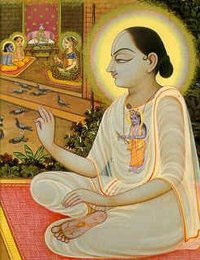 Sri Vallabhacharya
He is the presiding deity of the
Vaishnava sect of Sri Vallabhacharya , which follows what is known as
the “Pushti Marg” or the way of grace. His son Vittal Nanthji is the one
who institutionalized the worship of the little Lord in Nathdwara.
Vallabhacharya had called him Gopalji and the place was named
Gopalpur
but later Vittal Nathji changed his name to Srinathji. The most ancient
reference to Sri Nathji comes in the scripture known as Garga Samhita
where he is referred to as Devadaman Srinath. Devadaman means the one
who won a victory over Indra, king of gods.The cowherds of Vrindavan were in the habit of making offerings to Indra, since he is the one who gave rain which allowed the grass to grow on the hillsides of Govardhan and enabled their cows to graze and yield milk which was such an essential commodity for the cow herd settlement. Once when preparations were being made for this special ritual, Krishna stopped his father and told him that it was useless to make offerings to Indra who never accepted their offerings. Krishna told his father that it would be better to offer the same to the hill Govardhan which was the one which stopped the rain clouds and forced them to shed their waters on the hillside. Krishna’s father, Nanda reluctantly agreed to this and on the fixed day, all the gopalas went up the hill and presented their offerings to the hill. It is said that Krishna appeared in a huge form as the symbol of Govardhan and consumed the vast quantities of food placed on the hillside!! Of course he had previously seen to it that the gopalas had made only the types of food which he himself loved! 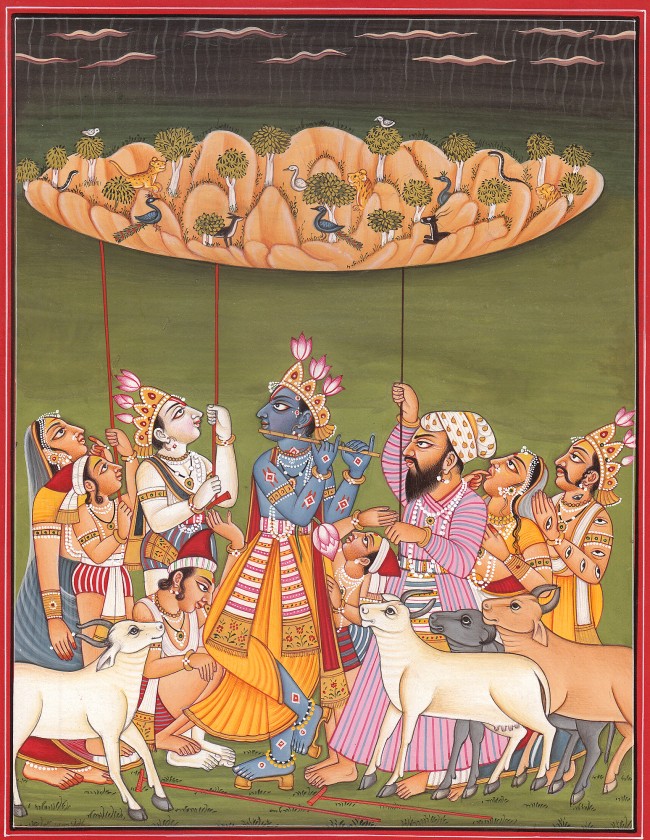 Govardhan Puja 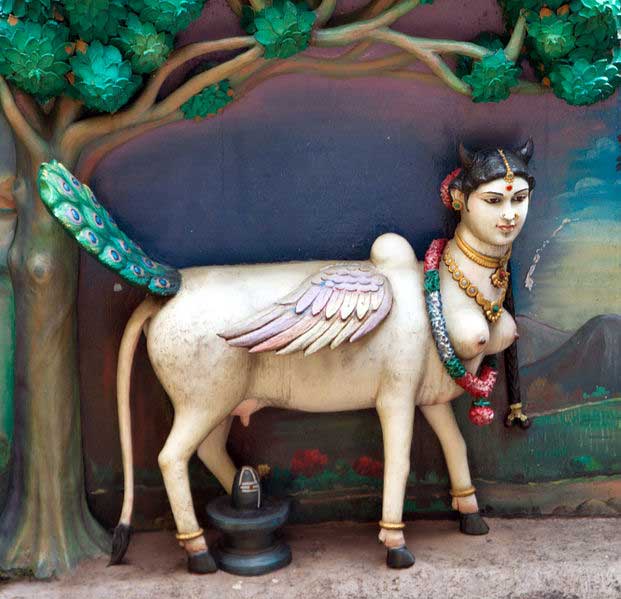 Surabhi (Batu Caves) It is said that
Indra brought the celestial cow, Surabhi and prostrated to Krishna and
begged his pardon for having been so stupid as to test the Almighty
Himself. Surabhi bathed him in her milk and both of them extolled him
much to the surprise of the cowherds who were watching this amazing
scene. Srinathji is the hero of this particular episode in the life of
Krishna.
In the 16th century, an uplifted left hand appeared on Govardhan hill and later the face also appeared. This was worshiped by the people of Vrindavan. Later the Lord appeared to Sri Vallabhacharya, the great 16th century Vaishnava saint of South India and asked him to go to Vrindavan and establish the method of worship for the idol. He did so and this tradition was carried on by his son Vittal Nathji and is still followed to this day. In the year 1672, when Aurangzeb unleashed his hatred of the Hindus and started a fierce destruction of Hindu temples, the Lord himself told his devotees to remove him to a safer place. Thus under secrecy of the night the little idol was carried in a palanquin to Agra where he remained for six months. Later when the emperor’s forces were looking out for him, the Lord told his devotees that he wanted to go to the state of Mewar. He was removed under great secrecy and travelled through difficult terrain for many months. At last when they reached the village of Sinhad in Mewar, the wheels of the chariot in which he was being carried sank into the mud and nothing could make it move. His devotees realised that the Lord had chosen his own abode and proceeded to build a temple there in which he was installed under the patronage of the Maharana Raj Singh of Mewar. The temple is referred to as the Haveli since it is not built like a normal temple but is situated in a fortified mansion, which was once the royal palace of the Rajput rulers of Mewar. The temple has many rooms designated for different purposes. There is a garage in which the original chariot in which Srinathji was brought is kept. There is a store room for milk (Doodhghar), a store room for betel leaves (Paanghar), a store room for sugar and sweets (Mishrighar and Pedaghar), a store room for flowers (Phoolghar), a functional kitchen (Rasoighar), a room for jewels (Gahnaghar), a treasury (Kharcha bhandaar), a stable for horses (Ashvashala), a drawing room (Baithak) and a gold and silver grinding wheel (Chakki). There are some tailoring rooms also in which tailors work all day to make the fantastic outfits in which Srinathiji is clad.All the elaborate preparations for the Lord’s pujas, is carried on in these various rooms. 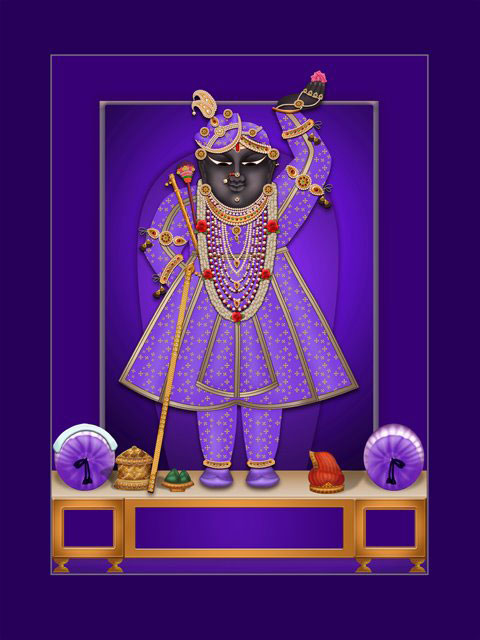
Sri Nathji The idol itself is carved out of a monolithic
black marble stone and has images of two cows, a lion, snake,
two peacocks and one parrot engraved on it with three sages standing
near it. He is adorned with intricately woven clothes in silk,
embroidered with gold thread and wears exquisitely worked jewels, some
dating back to the pre-Mughal period. Srinathji is referred to as
Thakurji by the locals since it is considered disrespectful to refer to
him by his actual name. His Vrindnavan devotees still hope that he will
return to Govardhan some day.
The main attractions in the temple is the special way in which he is dressed and decorated as if he is a living child. He is adorned with appropriate dresses for every season. He has summer and winter clothes and also special attire for mornings and evenings. The formal pujas are not open to the public but are all done behind closed doors. Many things are offered to him like lights, flowers, fruit and perfumes. He is also entertained by the local instruments and devotional songs which are played according to the demand of the time and occasion. The view of the idol after the parda (curtain) is removed is called jhakhi and this is what the devotees rush to have a glimpse of. The arati which is conducted when the curtain opens is seen only by a very few people since there is always a rush. 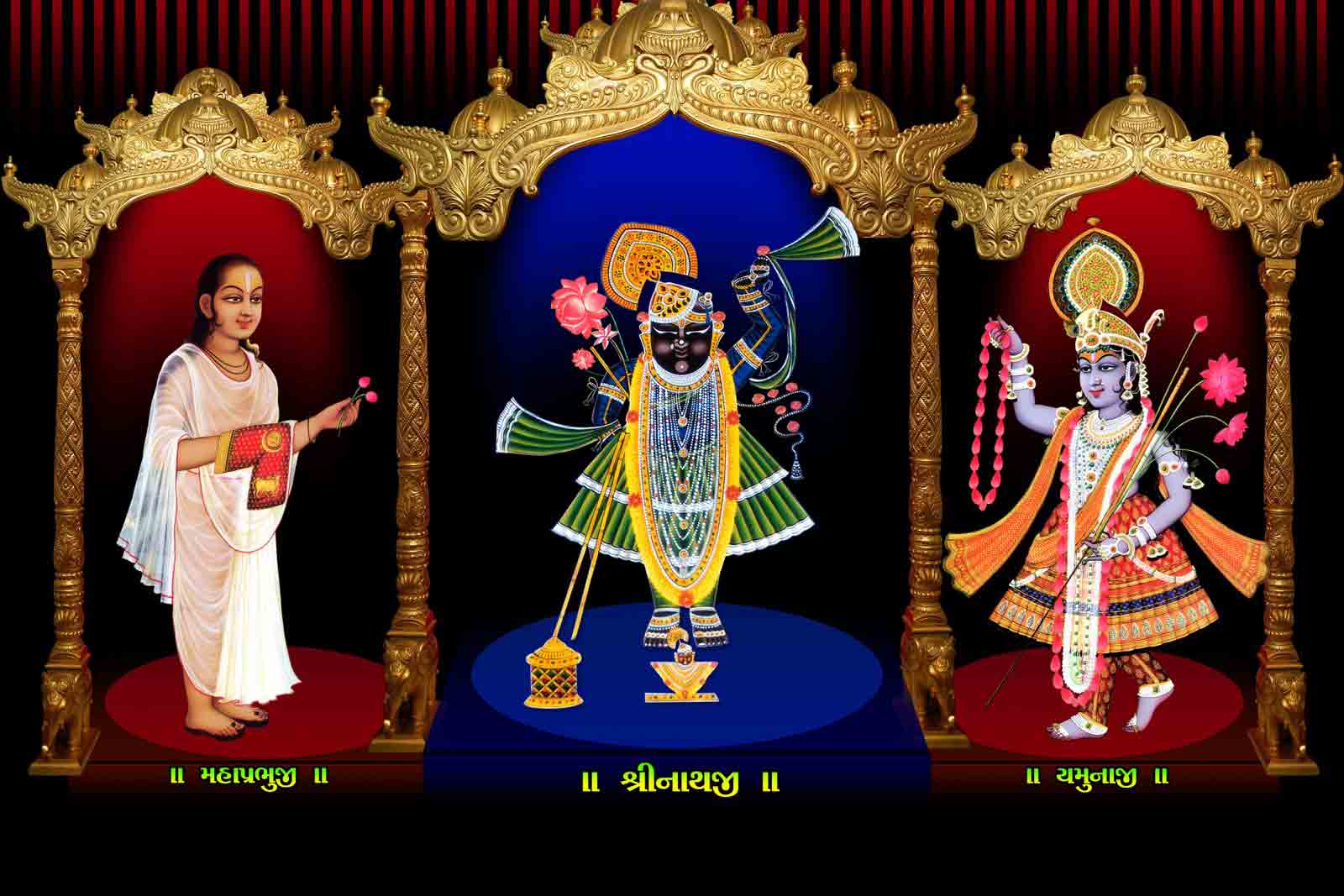
The elaborate set of rituals which are performed in the temple has its
basis in the account given of the way in which his mother Yashoda used
to look after the child Krishna. The gopis wanted to see him all the
time and were always hanging around her house and thus he never got time
to go and play with his friends so his mother kept specific times when
he could be seen by the gopis. This was mainly after his meals and
snacks and rest. Following this pattern, Sri Vallabhacharya decreed that
the temple would be open eight times when the public could have darshan
of their little darling like the gopis used to do. In between it is
believed that he goes off on his nefarious errands with his
friends!
We reached Nathdwara in the evening at 6 so we had a quick wash and set off to the temple which luckily was only a stone’s throw away. My sister has some problem with her knees but she was able to manage the walk. Unfortunately some person tempted us with a special darshana and took us in only to be squeezed unbearably by the rush. My joy at seeing him was dimmed by this unpleasant episode. The next day I was
anxious to go for every puja so I arrived at the temple bright and early
at 5 am. This viewing is known as Mangala and is really one of the
sweetest. Just outside the temple there were a number of vendors selling
lovely flowers for the morning puja. I bought a whole basket full of
lovely roses and someone offered to take me up to the flower room
(phoolghar) where I was personally allowed to place the flowers in the
plate reserved for it. When I came down someone caught me and asked me
to offer some milk for the Lord. I readily agreed and bought five kilos
of milk and again the man took me up to the kitchen where I could pour
the milk into the vessel reserved for it. The next to catch me was the
pan-wallah who was a young boy who had arranged the betel leaves on a
tray in a most artistic manner and who escorted me to the “panghar”.
Apparently he is offered a hundred and eight pans every day. This is one
thing I noticed in Nathdwara. All his attendants in the temple are all
very artistic. They arranged the flowers and the pan and everything very
beautifully. It was not tossed altogether into a basket. After coming
down, the boy asked me if I would like to offer vegetables. I was very
eager to do so and he took me to another part of the palace where
vegetable sellers were lined up with all sorts of vegetables. Luckily
the boy was with me so I wasn’t cheated. Actually the flowers and
vegetables were all so cheap when compared to the cities that I would
surely have been cheated had he not been there. This again had to be
delivered to another place.

By this time I found that the gate at which the ladies were waiting was
already open and every one had rushed in. I too ran in to have a look at
the little one whom I had only had a glimpse of the previous day. I
gasped with delight when I saw him. This Mangala is supposed to be the
most auspicious of all the darshanas. He has just woken up and had
a small snack and is all ready to meet his devotees. He had not had his
bath and was muffled up in a lovely deep blue satin embellished with
gold and silver right up to his chin. Above that his glowing,
mischievous face looked at me with a charming smile. I couldn’t tear my
eyes away from that fascinating face and miraculously despite the
thronging crowds I found that I was left totally unmolested and was able
to stand right in front of him and stay there till the curtain was
drawn for the end of the session. The priests have a small game they
play at this time. They draw the curtain and allow the crowds to go and
then open it again and everyone rushes back. I caught on to this game
and for the rest of the pujas I just stayed on till the whole game of
opening and closing was over. Often he seemed to tell me when to go and
when not to. The viewings are only for about half an hour each and even
then a lot of favoritism is shown to the men who are allowed to go in
first. Only after they have had their darshana is the gate opened for
the women. I was a bit sad about this and wanted to tell the people in
charge that Krishna always allowed the gopis to come to him and that he
would certainly not have liked this discrimination!
The next is the
Sringar darshana when he is bathed and dressed and given his breakfast.
At this time he is in a hurry to go and play with his friends so we are
given a quick darshana at seven a.m. Of course in this he was fully
ornamented and clad in a lovely deep blue outfit with a cocky headgear
stuck with a peacock feather.
The next puja is at nine O’clock and is called gval. He is worshiped by reciting his thousand and one names in which one tulsi leaf is offered with each name. This is the time when he has just had his mid-morning snack and is ready to go off to the forest with his cows and calves. Of course I was already in the temple but held back a little. I had discovered that by trying to rush in with the first crowd you only get jostled. If you wait for the last few minutes, you can have a lovely darshana without being pushed around. Again I could stay for a long time right in front and repeat the whole of the Vishnu Sahasranama standing in front of him. Of course the tulsi leaf had to be offered mentally! I was charmed to hear that there is a mandir to Vanamali just next to the temple. So of course before the next puja I trotted off to see Vanamali who actually looks exactly like Srinathji. Then I went to a temple to Mirabai the beautiful princess of Mewar who gave up everything in the palace and wandered out like a mendicant because of her love for her darling Giridari. The next puja is the Rajbhog and is at 11 am. Here he is in his most regal attire and is supposedly resting after his mid-day meal. Garlands and lotuses are offered to him and he plays “chopat” an ancient board game which is a version of our modern chess. My sister wanted to have another darshana so we all went together for this. 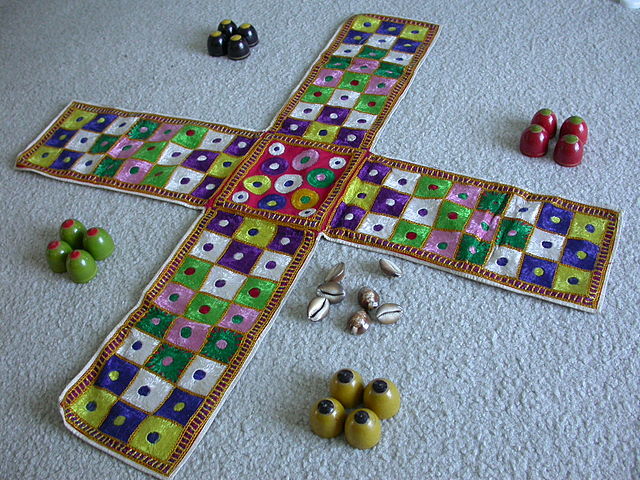
Chopat Board
Next is called Uttanpan and is at four pm. He has just woken up from his afternoon siesta. Actually we are only allowed a glimpse of him at this time and we are all herded out but allowed to go back in twenty minutes at five O’clock and this is known as “Bhog” when he has had his afternoon snack and is all set to go out and play with his friends. Next is known as “sandhya” when the sun dips over the western horizon and the Lord returns to Gokulam with the herds and his friends. The gopis rush to greet him and so did I with the rest of the crowd which was anxiously waiting. This is at five pm. Just as his mother used to ward off the effects of any evil eyes so also an arati is done to him with waving of lights and ringing of bells and then he goes off for his evening bath. The last darshana is known as “shayana” and is at seven pm. He has just finished his evening meal and is on the verge of going to bed. At this time he allows his devotees to have a glimpse of him before he jumps into bed. Once again he is bundled up in another colourful blanket. I gaze and gaze and come back again and again for another and another darshana since I’m not sure if I would be able to make it for the next morning. He plays many tricks with me and keeps opening and closing the curtain and once he even closed the doors but I hung around and what do you know they opened the doors and I could have one last darshana of the beloved. I was in a cloud of
elation when I left the temple that evening. I could hardly bring
myself down to the mundane task of having dinner. When my sister asked
me why I wanted to go to every single puja what could I tell her? The
joy I experienced during these strange viewings when it appeared as if
he was playing a game with me, tantalizing me with his beguiling looks
and tempting me to go again and again, is something quite indescribable.
It shall remain a secret between him and me.
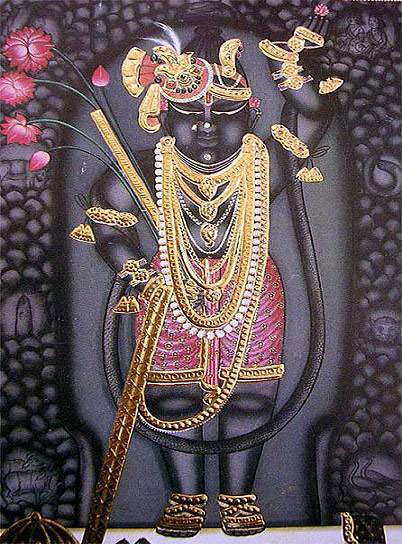
Sringara Darshan
A special treat after the Mangala was the “utkala” chai – a special tea
made by a boy just outside the temple gates only at this time when all
those who have had t he morning darshana get the privilege of having.
It’s a strange concoction made with all types of masalas and mint leaves
all thrown together with water and milk and boiled and boiled. This is
served in a small mud cup which can be thrown away later. I washed and
kept mine since it seemed such sacrilege to throw it away. The tea has a
delicious and unique taste which I have never had anywhere else. So I
took it to be part of the Lord’s prasad. I left with many backward glances after he promised to come to me every day on those occasions when the curtains closed and he is supposed to be playing with his friends or resting. So I’m anxiously waiting for the time when he will come for I feel sure he will arrive one day. In fact tradition has it that he loves Vraj so much that during the summer months he rushes back to Vrindavan in order to play with his friends after the sandhya. So during those months the “shayana” arati is done in Vrindavan and only in winter is it done in Nathdwara. How happy I was that we had gone in winter. I left knowing that my darling Vanamali and Giridari were one and the same. Hari Aum Tat Sat
|















